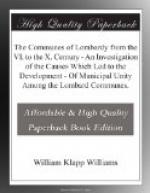Turning now to the territorial divisions of the country at this period, we find them practically unchanged. The civitas still stands as the sectional unit; the territory with its city still represents the administrative division of the state. It is fundamental to a correct understanding of the early development of communal institutions that we should have a thorough knowledge of the meaning of this term civitas; of the extent of its application and of its limitations. I used the words “territory with its city” in defining the administrative division of the state, and perhaps this term describes the civitas better than any single word would do. In the Roman municipal system we have the city with its surrounding territory, over which extends the jurisdiction of the curia; in the Lombard system we have the territory, the land, in some part of which is located a city, a fortified place.
This is to my mind the important point which settles satisfactorily the vexed question of the dominance or the disappearance of Roman influences. The institutions of the Lombards were similar in character to those of the other Germanic races, and the continuance of any overruling municipal influence among them would have done violence alike to their traditions and to the nature of their race. The old municipal predominance as a system disappeared, the old municipal divisions and many of the minor forms and offices as a fact remained. It is these latter which give some color to the arguments of writers like Savigny,[12] who endeavor to maintain the continuance of the old Roman curia. They find evidence of the continuance of old boundaries, of many old names and many old executive functions, and fail to appreciate that the principle which lay back of and was making use of these old forms as convenient channels for the expression of its power and of its control, was an entirely new one, based on ideas fundamentally opposed to those of the civilization it had conquered. This slight warning is necessary so as to avoid any error in the conception of the significance to be attached to the geographical limits of the divisions of territory we are considering.
The word civitas has the same signification as comitatus, when that word was used with the meaning of a territorial division; and included all the territory, with its lands, its villages, its fortified places and its city, which came under the jurisdiction of a dux or judex, or in Frankish times of a count, when we are strictly justified in giving it the more familiar name of county. From this we trace the Italian word contado, by the steps comitatu, comitato, contato, contado. The land division here indicated is indifferently called in the Lombard records territorium, fines, civitas, or judiciaria. The identity of all these terms admits of easy proof from all the documents, public and private; and numberless instances could be cited showing an interchange of terms in describing the same locality.




